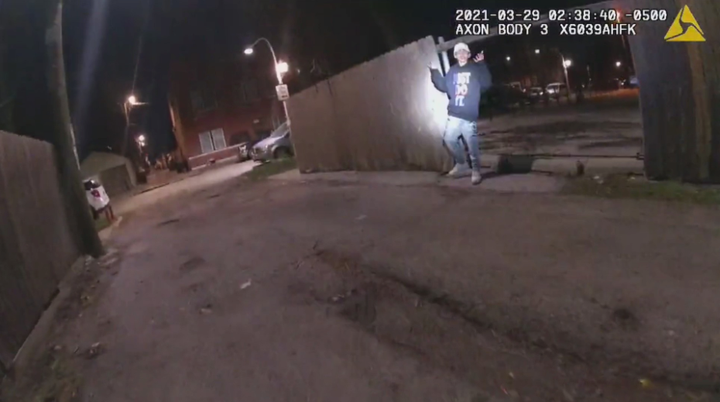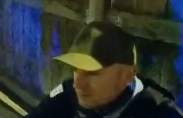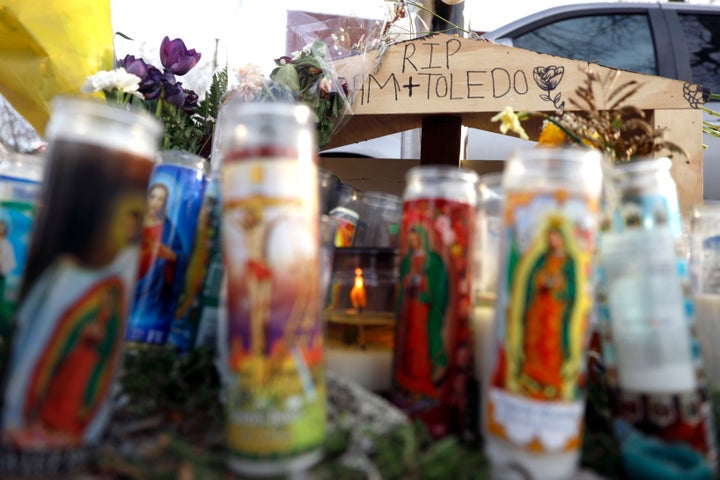Chicago’s police oversight group released footage Thursday of an officer fatally shooting a 13-year-old boy more than two weeks ago.
Police pursued, shot and killed Adam Toledo early March 29 in the primarily Latinx neighborhood of Little Village on the southwest side of the city. Police said the shooting followed an “armed confrontation” and that the child had a gun. However, video footage shows no gun in Toledo’s hand and that he complied by putting his hands up.
As a seventh-grader, Toledo is the youngest person in years to be killed by Chicago police. The Civilian Office of Police Accountability released materials on Thursday that include 17 body camera videos, four third-party videos, police incident reports, one officer radio transmission, two 911 calls and six recordings from the ShotSpotter gunfire detection system.
“If you’re shooting an unarmed child with his hands in the air, it is an assassination,” Adeena Weiss-Ortiz, the Toledo family’s attorney, said at a press conference following the video’s release.

Bodycam footage shows two officers getting out of a car and immediately chasing after someone. A female officer can be seen tackling and handcuffing a taller person in a beige coat with red gloves. A male officer continues to pursue Toledo on foot while shouting, “Stop right fucking now, show me your fucking hands, stop it!”
Almost immediately after shouting at the child, who had put his hands up, 34-year-old officer Eric Stillman shoots him in his chest. Toledo is wearing a black hoodie and a white baseball cap and is seen lying in the alley with blood on his clothes and face, mouth agape.
The officer calls for an ambulance and asks Toledo where he was shot, but the boy is unresponsive. Additional officers can be seen coming over to Toledo, telling him, “Stay awake, man” and attempting chest compressions until an ambulance arrives. The officer who killed the boy shined a light on the back of the fence where he was lying, showing a gun several feet away.
Toledo was pronounced dead on the scene.
Stillman identifies himself in a tactical response report posted by COPA. The report includes a set of boxes for officers to check, in which Stillman made claims about Toledo’s behaviour ― many of which aren’t proven in the bodycam video. The officers alleged in the report that Toledo did not follow verbal commands, fled, posed an imminent threat, used force likely to cause death or great bodily harm, and was armed with a semi-automatic pistol.
The female officer tackled 21-year-old Ruben Roman, who prosecutors say fired the initial gunshots. Roman told police that he had just dropped his girlfriend off and was on his way to his hometown of Maywood via public transit when he was tackled. He said he thought so many officers arrived at the scene because of “shots fired.”
“He’s gotta be some kinda King,” one officer said of Roman, who was on the opposite side of the alley from Toledo, referring to a gang affiliation.
Before the video’s release, prosecutors claimed officers were dispatched after a ShotSpotter detected eight gunshots nearby and that Toledo and another person fled as police arrived. Two officers chased the boy and Roman into an alley, where one of the officers shot and killed the child.
Mayor Lori Lightfoot said she had previously seen what she called on Thursday the “excruciating” video of police killing Toledo, but would not talk about what she saw because she said it could compromise ongoing investigations by COPA and the Cook County State’s Attorney’s office. She previously vowed to find the people responsible for “putting a gun into the hands” of Toledo, shifting the blame away from the officer who shot him.
During Roman’s bond hearing, prosecutors alleged that Toledo had a gun in his hand when police shot him. At a news conference on Thursday ahead of the video’s release, Lightfoot said the details of the boy’s death released in court were correct.
But right after the mayor’s press conference, WGN-TV reported that the state’s attorney’s office said its own detail about Toledo having a gun when he was shot was inaccurate.
“An attorney who works in this office failed to fully inform himself before speaking in court,” Sarah Sinovic, a spokesperson for Cook County State’s Attorney Kim Foxx, told WGN on Thursday. The news came just hours before COPA released video of the encounter, which did not show a gun from bodycam footage of the officer who killed him.
Footage from a camera across a parking lot next to the alley showed Toledo’s right arm moving behind the fence in a tossing motion before putting his hands up.
Weiss-Ortiz said that she won’t deny it was a gun Toledo tossed, but that it’s irrelevant because he was unarmed with his hands up when the officer killed him.
“I don’t think it matters whether Adam is a choir boy, whether he is involved in some other untoward activity; the fact of the matter is that he was walking in the street and he was shot unarmed,” Weiss-Ortiz said. “That could’ve been me in that street, that could’ve been my son in that street, that could’ve been any one of us in that alley that evening.”
Stillman’s attorney Tim Grace said he had seen all the footage and did not expect his client to be charged with any wrongdoing or crimes, according to Block Club Chicago.
Stillman has been on the force for a little over five years. There are no previous allegations or use of force reports against him, according to the Citizens Police Data Project, which collects and publishes information about the city’s police misconduct.

Toledo’s family was not notified of his death until two days after the shooting. Police said the delay was due to being unable to identify him, despite a missing person’s report filed days earlier. Roman faces several felony charges, including child endangerment.
“I have seen those videos and they are particularly difficult to watch ― especially at the end,” Lightfoot said at Thursday’s presser, calling for people to withhold judgment until COPA finishes its investigation. “Simply put, we failed Adam.”
COPA allowed the boy’s family to privately view the footage Tuesday, an experience that the Toledo family attorneys said was “extremely difficult and heartbreaking” for everyone in the room. According to the Toledo family, the child lived with two of his siblings, his mother and his grandfather.
The family requested that COPA delay releasing the footage as relatives still grieve Toledo’s death. COPA said that although it is “acutely sensitive to the family’s grief and their desire to avoid public release” of the video, the office is required to comply with the city’s video release policy that mandates footage be released within 60 days of the incident.
Chicago Police superintendent David Brown said April 5 that “one of his greatest fears has been a deadly encounter between one of our officers and a juvenile,” before including a defence of police who he said carry “a heavy burden” when it’s time to “make split-second decisions” about deadly force.
Toledo’s death reignited the grief and trauma Chicagoans have felt before, specifically from when a Chicago police officer shot at 17-year-old Laquan McDonald 16 times and killed him. Lightfoot’s predecessor, Rahm Emanuel, withheld dash-cam video of McDonald’s murder from the public for over a year, until a lawsuit forced the city to release it. The cover-up is considered a major stain on Emanuel’s tenure as mayor.
Lightfoot has lost considerable trust from the public during her time so far as mayor, especially when local station WBBM-TV released body-cam footage of heavily armed officers raiding the wrong home, breaking the door down and handcuffing a naked woman in distress. The incident with Anjanette Young happened in February 2019 ― just months before Lightfoot took office ― however, Chicago police under Lightfoot tried to block Young from obtaining video of her own trauma, and the city’s lawyers attempted to block WBBM-TV from airing the footage.
The mayor also came under fire after media outlets reported that Lightfoot spent $281.5 million in federal Covid-19 relief money on covering overtime pay for police officers instead of on needed housing relief, business support and vaccine outreach for Chicagoans most affected by the coronavirus pandemic. Lightfoot faced harsh scrutiny from both activists and aldermen who accused her of prioritising the police department over working families.
Protests demanding justice for Adam Toledo and his family have been passionate and peaceful. The child’s tight-knit community of the Little Village (locally known as La Villita) held a vigil to mourn his life, and residents marched in the boy’s name. Community leaders spoke about the anger and pain of once again losing someone so loved to police violence, and of the overpolicing that Chicago’s Black and brown neighborhoods face.

Even with the peaceful protests, tension in the city ahead of the release of the reports and video footage was palpable. CPD has informed officers that days off will be cancelled and shifts will be extended to 12 hours in anticipation of potential civil unrest.
Lightfoot released a joint statement ahead of the video’s release on Thursday with her legal department and the Toledo family’s attorneys. The statement said that both sides agreed to releasing a slowed-down compilation of the encounter that led to police killing the boy.
“We acknowledge that the release of this video is the first step in the process toward the healing of the family, the community and our city,” the statement read. “We understand that the release of this video will be incredibly painful and elicit an emotional response to all who view it, and we ask that people express themselves peacefully.”
The Chicago Department of Transportation announced that a bridge over the Chicago River will be raised Thursday night for “testing and maintenance” and says the closure is unrelated to the video’s release. Lightfoot and the city faced intense backlash last summer for raising the bridges that connect downtown to the city’s neighborhoods during protests against racial injustice and police brutality.
That decision, along with Lightfoot’s call to stop public transit from entering downtown, made it difficult for protesters to escape police violence and go back to their homes, according to an inspector general’s report on Chicago police’s handling of the protests.
